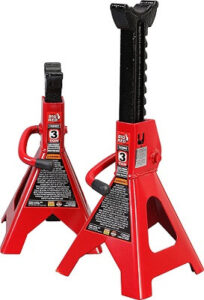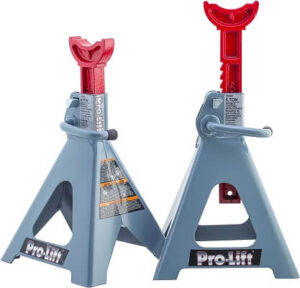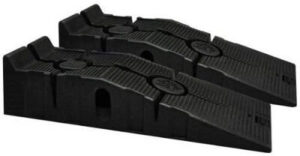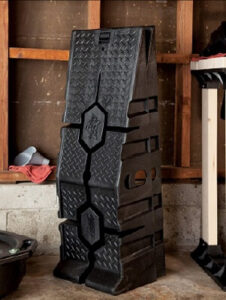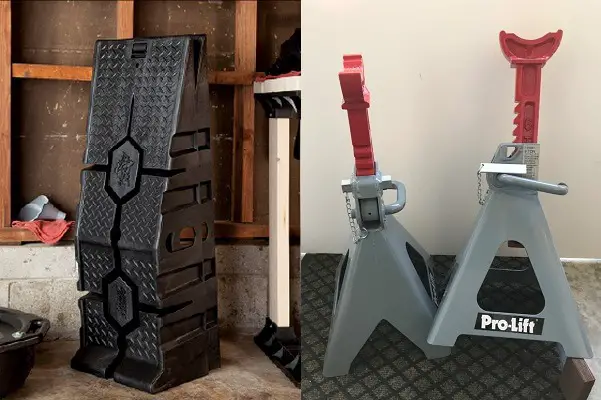
Jacks and ramps are quite the equipment; having them is a smart idea. However, there is a difference in the usage and the purpose of either.
If you are working on suspension, that’s where jack stand and floor jacks will come in handy, whereas; a ramp works for tasks like simple oil changing, etc.
To know more about jacks and ramps and how each can be a life-changer, keep on reading:
What is a Jack Stand?
Jack stands are mounted or pinnacle molded instruments intended to help a vehicle’s weight when suspended and keeping it in a place.
Jack stands are one of the must-have carport apparatuses for replacing tires as well as an oil change, introducing suppressors, assessing exhaust pipes, and other DIY fix occupations.
They are situated under the vehicle hub or casing to offer extra help for the raised vehicle. Place the jack stand after you jack the car up.
The height of the stand can vary, as does its weight capacity.
The material is commonly either steel, solid metal, or aluminum. The stature can either be fixed or customizable, differing from 13 to 25 inches.
It measured as weight in tons, accessible to hold any weight from 1 ton down to 50 tons.
What is a ramp?
Car ramps are more of a driveway sort of equipment. They provide a more convenient and safer maneuver than a jack stand or an axle stand, especially when working on a sloped driveway.
Although I never recommend that, always look for a flat surface. Once you line up the ramp with the wheels (rear or front), it’s all a matter of slowly driving on to them.
A ramp is a piece of equipment that provides a lift to access the vehicle’s undercarriage while giving you the advantages of easy lifting and safety.
Ramps classify based on the material they remade, like plastic steel, wooden, hydraulic, and lifting. Some are heavy-duty, while some serve more commonly for lighter objects.
A few ramps have a slight plunge at the top to tell you when the wheels are resting securely in position. The necessary stature will impact the length and point of the ramp.
Bigger vehicles require more tallness and a more extreme point, so make sure you get the right length.
Difference Between Jack Stands vs Ramp
A car jack is different from a car rank in various ways, functionality, performance, etc.
Time spent under the vehicle
Jack stands are useful when the operation isn’t very time-consuming. If you are to spend my time under the vehicle, I’d suggest getting ramps. They make the whole process more comfortable and safer.
The wrong location can cause damage
Many people place the jack in the wrong position, in the wrong way causing all sorts f damage to the vehicle, stand, and even themselves with the unstable lift.
The correct way to place the jack stand is to place it closest to the jack itself, usually the approved points.
Usually, it’s hard for some people to find these ‘approved spots’ given every car has its unique design. It’s safest to stay close to the designated lifting points. Ramps don’t raise this concern.
Height and Adjustability
Jack stands to provide a range of adjustability regardless of the workplace, a garage, a driveway. Any place would work.
If you remove the transmission or do anything that requires a higher lift, jacks are your thing.
Pairing a ramp with the jack stand can always be useful if the job doesn’t require that much height. However, low vehicles won’t make it easy to drive on a ramp.
Ramps will, in general, spread weight more successfully than a jack stand so they can adjust to a more extensive range of surfaces; hence, the stability is guaranteed as well.
Picking up from the front
A jack is more suitable for solo action. Ramps always cause a front air dam clearance issue.
Most cars come with marked reinforcements looking like an old-school frame rail situated just under the floor pan. I recommend using the jack in this area.
Using a 1×4 to disperse, the load is always smart as it acts as insurance against the floor pan crushing.
Putting the jack stand under the A-arm mounting spots also works similarly.
Is a ramp suitable for trucks as well?
Trucks are pretty darn heavy, so using a ramp for them is not the smartest thing to do. Jack stands to prove useful only when it comes to high ground clearance as of trucks.
You will only need a jack stand when the wheels are off; the ramp won’t work here anyway.
They provide the best performance in pairs, and as ramps are frequently plastic and don’t contain moving parts, so they watch out for keep going an incredibly prolonged period as there aren’t generally any things to wear or rust.
Jack stands are ideal for jobs like oil changing, an inspection of the brakes(pads/shoes), and bearing seals of the wheel.
They work great for smaller vehicles for ramps but don’t forget to place the chocks around the wheels before you go. You don’t want your ride to be rolling away while you’re in the middle of fixing it.
Drawbacks of a Ramp
I have not seen any driving scrubbing the top of his car ramp, but if you’re the clean-type, the ramp’s surface can be very tough to get the dirt off.
However, some ramps have a smoother top surface, which makes it harder to drive onto it.
You can solve this problem using some new concrete dust or 1×6 in the car’s front if it has a large front air dam or is a bit of low slung car; it’ll reduce the approach angle.
Ramps are more expensive as compared to jack stands, especially if you get metallic ones.
Whenever situated on a surface that doesn’t offer enough foothold, ramps can slide while you’re attempting to drive onto them.
Moreover, moving the vehicle back and forth to make room for mounting the ramps can be a tough deal in small spaces.
Recommendations for Jack Stand
- Torin Steel Jack Stands: 3 Ton
With a weight capacity of 3 tons and a lifting range of 11-1/4″ to 16-3/4″, this jack stand is a pretty sturdy piece of equipment crafted out of high-grade forged steel. From light-duty trucks to SUVs, it works great. The best part is that the jack stand itself is very lightweight, weighing around 7.7 tons only for a performance like this; it’s not much weight; Torin manufactures all its big red jacks in china. see the latest price click here
- Pro-Lift Double Pin Jack – 6 Ton
Pro-Lift double pin jack has a robust stamped steel structure that offers a weight capacity of 6tons along with a minimum lift height of 14-3/16 inches (when the tongue base is resting on the floor). The maximum locking height can range up to 22-7/8 inches. The minimum non-locking size of the first notch is 15-7/16 inches, whereas, in the locking state, it is about 16-1/8 inches. see the latest price click here
Recommendations for Ramps
- Rhino Gear Ramps
This ramp weighs around 18 pounds and offers a smooth maneuver with its durable polymer structure. It provides a 17degrees of inclination angle, which works fine for vehicles with low clearance. With a Gross Vehicle Weight of 12,000 lbs. it works great for cars with 9’tires. It’s effortless and easy to use all you need to understand is that it adds 6 ½ inches to the front bumper, given the working space is nice and flat. see the latest price click here
- Rhino Ramps MAX Vehicle Ramp
Manufactured in the USA, these ramps offer a high-end polymer design of 16.000 lbs. Gross Vehicle Weight and an inclination angle of 17 degrees, which works perfectly for low vehicles. For the ramp’s exact measurements, you can use a measuring tape to get the height, width, and length (6.5 “x10″ x35”, respectively).
However, the length/width is measured, including the plastic lip on the back and sides of the ramp that is about 1-2 inches. Actual measurements are smaller as the lip doesn’t count, but it doesn’t contribute much to the lifting height. see the latest price click here
How to use jack stands safely?
When it comes to operating, use the jack stand safely because any minor problem can cause damage not only to your vehicle but you as well.
Before using it, first know the type of jack you are using to make sure you are operating it the way it is meant to be.
Folding Jack stand
- Begin by placing the jack in a flat working space.
- Adjust the jack stand to the desired height.
- Once you have done that, slide in the locking bar into the hole.
- To ensure you use the jack stand safely, place the safety pin in the locking bar, which secures the jack in its position.
Standard Jack stand
It is more straightforward but not taking safety measures beforehand if a standard jack stand can damage more than a folding one.
- Place the stand under the vehicle in the right position. Make sure the surface is on is flat.
- Adjust the height of the stand by moving the lever slowly and gently.
- Place the pin at the point of the desired height.
- Check to make sure the pin is doing its job right.
How to use car ramps properly?
Car ramps can be a handful to deal with if you don’t know what you’re dealing with. Before using it, understand the dimensions first.
- Angle of approach
Use a yardstick and place it right in front of the front wheel and move the other end upwards until it touches the front of your car. That’s the angle of approach. You might also want to consider the rear tip for low-riding cars.
- Type
There are countless options, from classic steel ramps to rhino ramps. The point to consider here is that the ramps can support your vehicle’s weight, and the tires have enough room to fit in.
Safety Measures
It would help if you took safety measures beforehand as using a ramp recklessly can cause severe image. So to keep things hazard free:
- Look for any damage on the ramp. Please make sure the ramps are sturdy and have no impairment whatsoever.
- Keep them flat, almost to the surface level.
- The surface should be dry. No moisture, all slick-free working area. It will prevent the vehicle from slipping. If you use car ramps at home, make sure to clear the working space of any moisture or anything that’ll hinder the operation.
- Never forget to place wheel chocks around the tires. They keep the vehicle from rolling away.
Process
- Park the vehicle in a straight position with plenty of space in the front.
- Place the ramps right in front of the wheels and ensure they stay in their place and won’t move. Use the center marked on the ramp as a guide to place them.
- Drive the car onto the ramps, apply brakes, and turn off the ignition.
- Place wheel chocks before the rear wheels. That should do the job. You can use car ramps for an oil change and other time-consuming operations.
Conclusion
For a wrap, ramps will save you time and money, and they are much easier to use, but they won’t work if you need to fix suspension or access areas of fog lights, coil, or front pipe bolts.
You need to consider the size of the equipment you buy matters a lot. Getting one that serves its purpose right but gives you a hard time storing it can be a handful.
This problem occurs mostly with ramps. In such cases, low-profile jacks come in handy and save money, big time.

